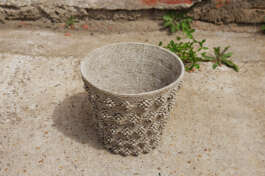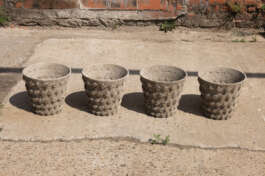



©Larbitslab
COLLECTIBLE In-Depth
LarbitsSisters
August 2025
This series, COLLECTIBLE In-Depth, unveils the backstage of contemporary creation. Tackling various topics from personal designer processes to the position of collectible design on the global design market, COLLECTIBLE In-Depth offers different views to suit all tastes. Today we speak with LarbitsSisters.
COLLECTIBLE: Can you talk about a new piece / collection that you release for COLLECTIBLE this year?
LarbitsSisters: Photosynthesising Flowerpots is an experimental piece featuring a flowerpot that photosynthesises, crafted through an uncanny symbiosis between a 3D printed clay structure and photosynthetic microorganisms.
While the pot structure provides a habitat for microorganisms and nourishes them with soil, moisture, sunlight, the cyanobacteria perform photosynthesis and gradually strengthen the structure of the flowerpot through biomineralisation.
This piece explores for sustainable processes, so necessary in the context of climate change. Crafts that symbolise thousands of years of human civilisation drawing man away from nature through art and the mastery of fire are brought back into a reciprocal relationship with the living.
C: What ethical considerations guide your material choices and sourcing practices in the production of collectible design pieces?
L: Photosynthesising Flowerpots challenges the concept of the flowerpot as a functional artefact. In an attempt to embrace the sustainable drives of living matter, the work raises questions that go beyond the technical and material, to address profound ethical and aesthetic issues.
Concerns about the manufacturing processes involved in living organisms guided our exploration to manufacture processes that cooperate with the living. We studied the cyanobacterium commonly found in moist, nutrient-poor soils. These organisms secrete a substance that binds sand particles through photosynthesis, thereby strengthening materials at low temperatures without the need for baking, a process known as biomineralisation.
C: How do sustainability-related questions influence your practice?
L: The current environmental crisis has prompted a shift in our approach to Earth, its ecosystems, and the life it sustains. We haven't realised the vital role it plays in our own survival, neglecting the life it supports. This has led to a devastating imbalance in the biosphere.
Photosynthesising Flowerpots is an attempt to move towards a more interspecies perspective, in which we see our lifestyle to be closely tied to the many species around us. Creative processes informed by life itself and a commitment to sustained development drive us to reimagine new materials and open up new and unknown manufacturing processes.
C: Can you discuss a specific cultural or historical reference that has inspired your recent work in collectible design?
L: A reference is the work and research of architect Achim Menges on Rethinking Materiality Through Computation which explores architectural systems that respond to climate conditions. The work is reminiscent of complex life forms and reveals the morphogenetic potential of materials.
Christina Cogdell's publication Toward a Living Architecture, has also had a significant influence. As part of our investigation into living systems, we use computational design to craft complex habitats for microorganisms. The life cycle of the materials was important here: we aligned production methods with the natural cycles of living systems to reduce environmental impact and damage.

© Larbitslab

© Larbitslab

©Larbitslab
COLLECTIBLE In-Depth
LarbitsSisters
August 2025
This series, COLLECTIBLE In-Depth, unveils the backstage of contemporary creation. Tackling various topics from personal designer processes to the position of collectible design on the global design market, COLLECTIBLE In-Depth offers different views to suit all tastes. Today we speak with LarbitsSisters.
COLLECTIBLE: Can you talk about a new piece / collection that you release for COLLECTIBLE this year?
LarbitsSisters: Photosynthesising Flowerpots is an experimental piece featuring a flowerpot that photosynthesises, crafted through an uncanny symbiosis between a 3D printed clay structure and photosynthetic microorganisms.
While the pot structure provides a habitat for microorganisms and nourishes them with soil, moisture, sunlight, the cyanobacteria perform photosynthesis and gradually strengthen the structure of the flowerpot through biomineralisation.
This piece explores for sustainable processes, so necessary in the context of climate change. Crafts that symbolise thousands of years of human civilisation drawing man away from nature through art and the mastery of fire are brought back into a reciprocal relationship with the living.
C: What ethical considerations guide your material choices and sourcing practices in the production of collectible design pieces?
L: Photosynthesising Flowerpots challenges the concept of the flowerpot as a functional artefact. In an attempt to embrace the sustainable drives of living matter, the work raises questions that go beyond the technical and material, to address profound ethical and aesthetic issues.
Concerns about the manufacturing processes involved in living organisms guided our exploration to manufacture processes that cooperate with the living. We studied the cyanobacterium commonly found in moist, nutrient-poor soils. These organisms secrete a substance that binds sand particles through photosynthesis, thereby strengthening materials at low temperatures without the need for baking, a process known as biomineralisation.
C: How do sustainability-related questions influence your practice?
L: The current environmental crisis has prompted a shift in our approach to Earth, its ecosystems, and the life it sustains. We haven't realised the vital role it plays in our own survival, neglecting the life it supports. This has led to a devastating imbalance in the biosphere.
Photosynthesising Flowerpots is an attempt to move towards a more interspecies perspective, in which we see our lifestyle to be closely tied to the many species around us. Creative processes informed by life itself and a commitment to sustained development drive us to reimagine new materials and open up new and unknown manufacturing processes.
C: Can you discuss a specific cultural or historical reference that has inspired your recent work in collectible design?
L: A reference is the work and research of architect Achim Menges on Rethinking Materiality Through Computation which explores architectural systems that respond to climate conditions. The work is reminiscent of complex life forms and reveals the morphogenetic potential of materials.
Christina Cogdell's publication Toward a Living Architecture, has also had a significant influence. As part of our investigation into living systems, we use computational design to craft complex habitats for microorganisms. The life cycle of the materials was important here: we aligned production methods with the natural cycles of living systems to reduce environmental impact and damage.

© Larbitslab

© Larbitslab
Contact
info@collectible.design
VIP PORTAL
EXHIBITOR PORTAL
PRIVACY POLICY
© 2025 Collectible
Contact
info@collectible.design
VIP PORTAL
EXHIBITOR PORTAL
PRIVACY POLICY
© 2025 Collectible